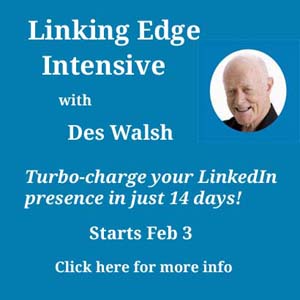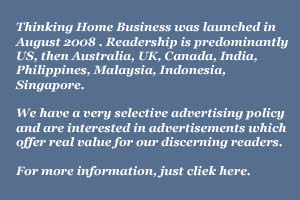The online network LinkedIn is for some people, including me, a great networking tool. For some others it represents a bit of a nuisance, in the form of emails from known or unknown people inviting them to “connect” on LinkedIn. What LinkedIn does is explained here:
Through your network you can:
- Find potential clients, service providers, subject experts, and partners who come recommended
- Be found for business opportunities
- Search for great jobs
- Discover inside connections that can help you land jobs and close deals
- Post and distribute job listings
- Find high-quality passive candidates
- Get introduced to other professionals through the people you know
I suspect that some of the people who see the invitations to connect on LinkedIn as a nuisance, but without investigating further, would in fact be interested to know how professional LinkedIn actually is and how powerful it can be as a way of organising our networks and building new connections of value to our business and professional aims.
Stan Relihan is an Australia-based recruiting wiz, a headhunter, who is a highly-linked person on LinkedIn. In an interview the other day he was interviewed by self-proclaimed Linkedin sceptic Cameron Reilly of The Podcast Network. The interview is a great introduction to LinkedIn – Stan meets Cameron’s challenging questions head on and in the process of responding he explains in down to earth terms how LinkedIn works from a business point of view. At the end, Cameron sets him an interesting challenge.
Stan has a huge network, with over 5,000 direct connections (i.e. “1st degree” connections in LinkedIn terminology) – he is Australia’s “most connected” person on LinkedIn.
I take a different approach to LinkedIn and my immediate LinkedIn network on LinkedIn is nowhere near as extensive as Stan’s: even so, the relatively smaller number of people in my immediate circle of connections on LinkedIn, 277, gives me access to a huge number of people, over 2.7 million at only three degrees of separation, out of the 9 million+ members of LinkedIn.
Some screenshots from my LinkedIn site give an indication of the reach and and range of connections, in terms of industry/profession and geography.
The first of the screenshots shows that my 277 people connected directly translates into over 2.7 million at the “3rd degree” of connections.

They range from the USA to Uzbekistan.

And LinkedIn shows me the industries represented.

One of the best ways to understand how to get value from a LinkedIn membership is to join one or more of the LinkedIn related groups on Yahoo Groups, particularly My LinkedIn Power Forum and LinkedInnnovators. Then there’s LinkedIn Bloggers, where I’m a moderator (if you apply to join, please provide your LinkedIn profile link in the comments box or we won’t be able to approve your membership). And for Australians, there is the new LinkedIn Australia group – of which Stan Relihan is one of the moderators.
Networking expert Scott Allen has an excellent site, LinkedIntelligence, devoted to showing how LinkedIn works.
For recruiters, there is a wealth of information in the e-book + recorded interviews with top recruiters, on how they use LinkedIn, which Bill Vick and I put together over a year ago, published as Happy About LinkedIn for Recruiting (couldn’t leave that out ).
For more information, check out the LinkedIn site. And basic membership is free.
Latest posts by Des Walsh (see all)
- Why I Love it – Sort of – When People Unsubscribe from My Updates - February 4, 2014
- Being Busy is OK, but it’s not an Excuse for Discourtesy - January 24, 2014
- Are You Using LinkedIn’s Power to Help Grow Your Business? - January 23, 2014





Rachel
I agree there are problems with LinkedIn (by the way, this post is nearly 2 years old now) but it’s not correct to say there is no way to refuse. You can click the link that says you don’t know the person: some people who are more “enthusiastic” about seeking LinkedIn connections actually ask the recipient to not do that. Also, I have to say that from the research my colleague Bill Vick and I have done there are plenty of *very* professional recruiters who have used LinkedIn responsibly and successfully. But evidently you have had only bad experiences and I’m sorry to hear that.
LinkedIn ‘invites’ – which, incidentally, there is no way to refuse: they just keep getting sent over and over until the sender and/or the LinkedIn PesterWare process finally gets the message that, surprisingly, it *really* wasn’t an oversight that you chose not to respond to the first unwelcome message, are spam, and are viewed as such by the vast majority of professionals I know.
The only people I’ve ever met that thought LinkedIn was a great idea were unprofessional recruiters, who mistakenly see it as a way to connect with professionals that have no interest at all in hearing from them. I’ve no doubt that, sooner or later, even those slow learners will realise that all this ‘service’ does is enable them to connect with 9 million+ other such delusional spammers, whilst annoying and alienating the very strangers they hope to build business relationships with.
Thanks for this. I’ve been slowly building up my network, until recently only responding to those who asked me. But recently, I’ve stumbled across people I know and invited them.
This summer, I’ll be experimenting with whether LinkedIn can help build momentum for social change, and specifically the Business Ethics Pledge, http://www.business-ethics-pledge.org